This was published 9 months ago
‘Imprisoned by history’: How Gaza became a mass death trap
By Mark Landler
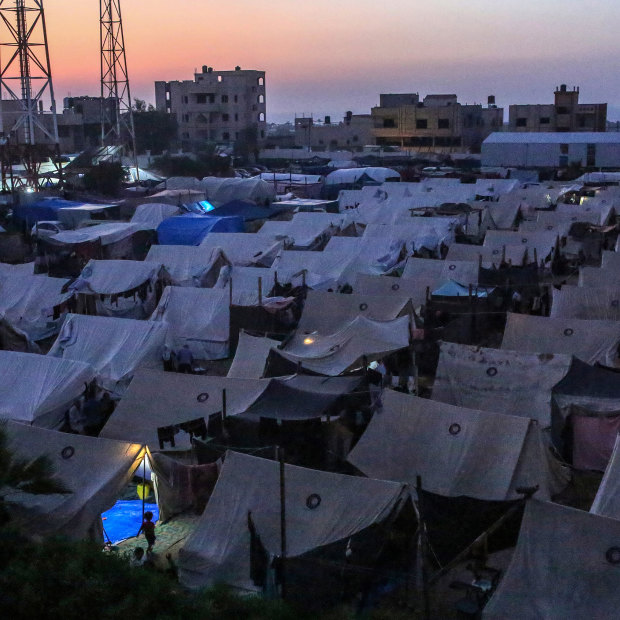
Tents for displaced Gazans near the southern city of Khan Younis, in the Gaza Strip, last year.Credit: Samar Abu Elouf/The New York Times
Of all the grim distinctions of the year-long war in the Gaza Strip that followed the savage Hamas attack on Israel last October 7, one may stand out for its deadly singularity: Palestinian civilians there have nowhere to go. Barricaded by barbed-wire fences, tanks and soldiers, they have been effectively imprisoned for 12 months in a 365-square -kilometre strip of land between Egypt and Israel that has become a killing zone.
That irreducible fact, rare in even the most catastrophic wars, has magnified the death toll from Israel’s military campaign to root out the Hamas militants. It has challenged not just Israel’s avenging army, but also Arab neighbours, Western powers, aid and refugee groups and human rights defenders.
Lacking the familiar, if tragic, cycle seen in other armed struggles – civilians are violently displaced and flee across borders for refuge – the world has watched the slaughter in Gaza with a kind of helpless horror.
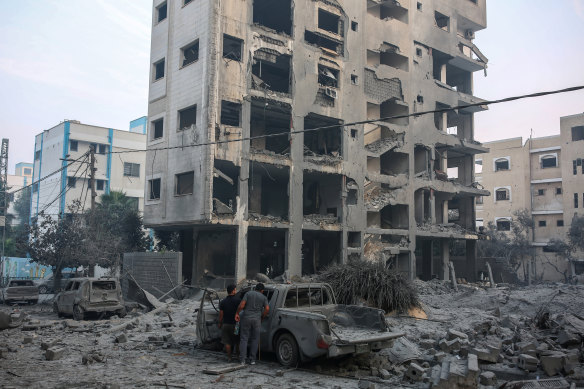
Palestinian citizens inspect their property after it was damaged by Israeli bombing in Gaza City in the Gaza Strip in October 2023.Credit: Samar Abu Elouf/The New York Times
More than 41,000 people have been killed, according to local health officials. While that number includes combatants, a majority were civilians, and the rate of casualties has at times outpaced even the deadliest moments in the US-led attacks in Iraq, Afghanistan or Syria.
“It seems unbelievable that these people, who have already endured so much suffering, are unable to leave,” said Zeid Ra’ad al-Hussein, a Jordanian former diplomat who served as the United Nations high commissioner for human rights from 2014 to 2018. “The world is not a kind and generous place.”
Yet, as Hussein noted, it is not wholly unprecedented.
From 1992 to 1995, Bosnian Serb forces besieged the city of Sarajevo, entrapping hundreds of thousands of residents and subjecting them to bombardment and sniper fire from the surrounding mountaintops. More than 5000 civilians were killed, making Sarajevo a milestone in what Hussein calls a steady ratcheting-up of the lethality of armed conflicts for civilians since the 1990s.
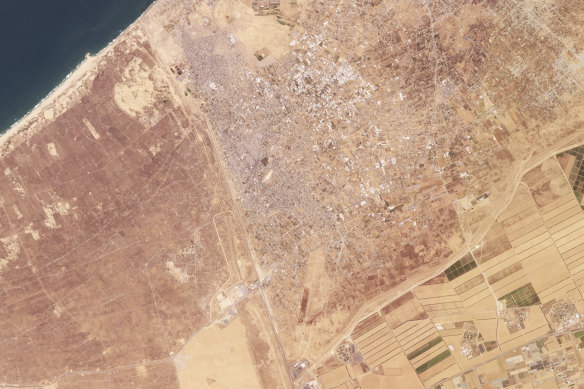
The city of Rafah in southern Gaza Strip in May. Egypt is to the left, Israeli farms on bottom right.Credit: Planet Labs/AP
Still, in the case of the Balkans, the world was willing to take in Bosnian refugees. The Israel-Hamas war remains, in that sense, sui generis. Its victims are not just barricaded by fences and guns; they are imprisoned by history: that of Israel, and their own. Hamas fighters massacred 1200 Israeli civilians and soldiers because of who they were. And the world has treated Palestinian refugees differently than any others because of the Palestinian struggle to carve their own state out of the land they share with the Jews.
When the UN adopted a convention on the treatment of refugees in 1951, it did not apply it to the Palestinians, nor were they to be protected by the new organisation, the UN High Commission for Refugees. Instead, the UN created a separate ad hoc agency, the United Nations Relief and Works Agency for Palestine Refugees in the Near East, known as UNRWA.
The thinking was that the Palestinian issue needed to be settled politically, through the creation of a Palestinian state, which would give the Palestinians a sanctuary like Israel became for the Jewish people after World War II.
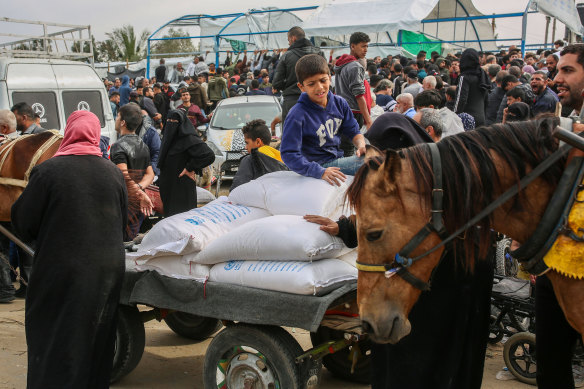
Flour is distributed by the United Nations Relief and Works Agency (UNRWA) at its headquarters in Khan Younis, in the southern Gaza Strip.Credit: Samar Abu Elouf/The New York Times
Until then, UNRWA would care for the Palestinians and their descendants, many of whom had lost their homes in the creation of the state of Israel in 1948. At that time, about 700,000 of them fled or were expelled in a forced displacement known by Palestinians as the Nakba, or “catastrophe”.
As a peace deal has eluded generations of diplomats, UNRWA’s mandate keeps getting extended. It has put deep roots into the Palestinian population, becoming the de facto administration in parts of Gaza and coexisting uneasily with Hamas.
“For the Palestinians, this is par for the course,” said Stephanie Schwartz, a scholar on migration politics at the London School of Economics. “Somehow, the world has siloed the Palestinian situation from the way we treat the rest of the world’s refugees.”
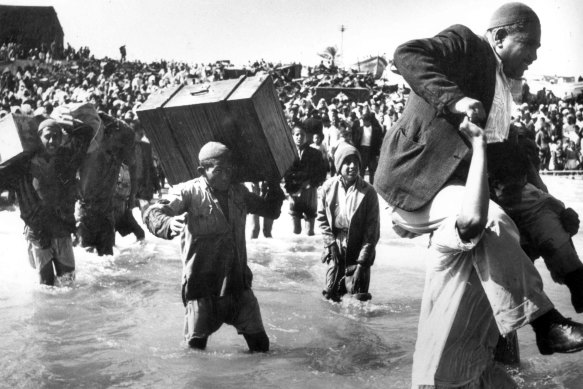
The Palestinian exodus: People flee their homes via the sea at Acre driven out by Israeli forces in 1948.Credit: Getty Images
There are no sprawling makeshift tent cities in Israel or Egypt to house refugees from the war in Gaza, like the vast camps in Bangladesh, which shelter more than 800,000 Rohingya from Myanmar; or in Uganda, which house some 200,000 victims of wars in South Sudan and Congo.
That reflects a bitter truth about the plight of the Palestinians: Israel does not want to let them back in because that would alter the character and demography of a Jewish state. The Arab countries to which many fled in the past do not want them, either because they regard such a large group of refugees as destabilising or because they view it as an effort by some in Israel to drive Palestinians out of the Gaza Strip.
So, while UNRWA operates large refugee camps for Palestinians in Jordan, Lebanon and Syria, as well as in the West Bank and Gaza itself, these are of little comfort to the 2.3 million people living in Gaza as the war has raged. Aid groups estimate that 90 per cent of Palestinians in the enclave have been displaced, some multiple times, because of relocation orders issued by the Israeli military.

Children – one of whom, being nursed by his mother, suffers from polio – in a tent camp in Deir al-Balah in Gaza.Credit: AP
Hamas militants hide among the civilian population, taking shelter in hospitals and schools. The ceaseless fighting has led to appalling conditions, with growing fears of famine and disease. The poliovirus has recently appeared, with the World Health Organisation warning that at least 90 per cent of children under the age of 10 must be vaccinated to stop it from spreading.
Such conditions militate against another basic pillar of refugee policy: that people cannot be forced to go back to their homes if they face torture, persecution or other human rights abuses. In the case of children, courts have held that they cannot be returned if they risk inadequate food or medical treatment.
“If Israel can attack terrorists living among civilians and destroy their homes, where are these refugees supposed to go?” said Harold Hongju Koh, a former US State Department human-rights official who is a professor at Yale Law School. “This is particularly true if polio returns in Gaza,” he said. “Where do you go when home becomes uninhabitable, not just from war, but from disease?”
When it comes to the Palestinians trapped in Gaza, Schwartz pointed out, even the vocabulary used by advocates for refugees does not seem particularly useful. Refugee groups tend to emphasise the rights of people who have crossed borders to escape war or persecution.
“One of the things to keep in mind is that the current refugee and asylum system inherently has a mobility bias,” she said. “The refugee and asylum system is not built for people trapped in a conflict.”
For all the suffering of those in Gaza, Schwartz said the war was as much about political choices as humanitarian ones.
“The choice not to push Egypt to allow people in; the choice not to push Israel to ensure the right of return for people who do flee; the choice not to supply the bombs that cause people to flee -- all of these are political choices,” she said. “Humanitarianism is not apolitical; it is political.”
The only way out of this impasse, she and others said, is to break the long-standing stalemate between the Israelis and Palestinians that led to the unique treatment of Palestinian refugees back in 1951. That foundational decision has been a trap for the West and the Arab world, no less than the Palestinians themselves, though Western leaders have not had to pay for their failed peacekeeping with the blood of their families.
“Everybody has got culpability here,” said Michael Posner, a former US assistant secretary of state for democracy, human rights and labor who now teaches at the Stern School of Business at New York University. “It’s a collective failure on the part of the West – the US and the Europeans – and the Arab states to force the parties to sit down and sort out their differences.”
This article originally appeared in The New York Times.